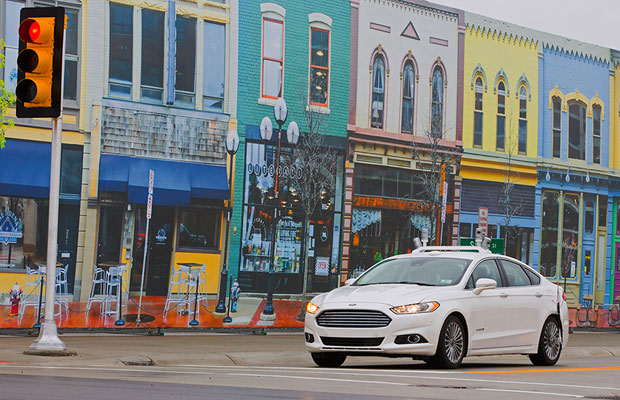Ford on Monday announced that it has begun conducting the automobile industry’s first autonomous vehicle tests in snow and icy conditions at Mcity.
The company is using Mcity — a full-scale, 32-acre simulated real-world urban environment that was developed as part of the University of Michigan’s Mobility Transformation Center — to test vehicles in a variety of weather conditions throughout the year.
Roughly 70 percent of U.S. residents live in regions that get some snow or other inclement weather, Ford said.
It highlighted the tests at the North American International Auto Show in Detroit.
“We expect the car to be able to drive in most if not all of the weather that a human can drive in,” said Jim McBride, Ford’s technical leader for autonomous vehicles.
“We need to monitor the sensors so that these can determine when conditions are deteriorating and it simply isn’t safe for anyone — including a self-driving car — to drive,” he told TechNewsWorld. “There are thousands of things an autonomous car must do, and that includes planning ahead to safely stop the car and when to know when it isn’t safe to drive.”
Real-World Conditions
The unseasonably mild weather in Michigan turn wicked just in time for the start of the auto show.
Other auto and tech companies primarily have been testing in the ideal weather conditions of central California, Ford said.
In a video presentation published to the Web on Monday and shown to the audience at the auto show, Ford unveiled the conditions that its autonomous vehicles are experiencing — and didn’t show much sun.
“The devil is in the details,” said Peter Harrop, chairman ofIDTechEx.
“Automakers need to understand that a car will face problems like drifting leaves or snow blowing across the road. These are things that the car must be trained to understand, and this makes it important to test in real-world conditions,” he told TechNewsWorld.
“If you know the problems, it is easier to understand a solution, and this can’t be accomplished just from wind tunnels or artificially iced-over testing facilities,” Harrop noted.
“The real world is going to throw a curve ball at you that you didn’t expect, especially in weather, and that again makes Mcity very unique for autonomous vehicle development,” said Maryanna Saenko, analyst for autonomous systems 2.0 research atLux Research.
Advanced Systems
Autonomous vehicles rely on a number of redundant systems, including Lidar. Determining how reliable these sensors are in a variety of weather conditions is crucial.
“The very reason Mcity was opened and a five-mile test track was set up for autonomous driving testing was to test the vehicles in dynamic weather to study/analyze sensor performance in a variety of conditions, especially vision and Lidar,” said Praveen Chandrasekar, automotive and transportation research manager at Frost & Sullivan.
“Just testing in California might give the vehicles enough data to react to heavy traffic congestion scenarios, but dynamic weather testing is required to calibrate sensors and get the best performance in order to understand how many Lidar versus camera versus radar is required for urban and highway automation,” he told TechNewsWorld.
Moving Forward
In poor weather, the data retrieved from the sensors needs to be cleaned up, as few sensors can handle poor conditions.
“It is only in the past year that we’ve seen advancements in this technology that can handle poor weather conditions,” Lux Research’s Saenko told TechNewsWorld.
Another reason for testing at Mcity is regulatory.
“There have only been a few places that have allowed testing of autonomous vehicles in road conditions, and California is one of those,” said Saenko.
“This is why Mcity is so valuable for testing, because regulatory barriers have been dropped,” she added.
More Than Weather
Ford has said very little about what the tests have revealed.
“This is really just the start of what is a very long process that will include testing of hardware sensors and software,” said Jeremy Carlson, senior analyst autonomous driving at IHS Automotive.
“They need a ton of miles and exposure to these conditions before they update the technology, refine it, and learn how it adjusts to those conditions,” he told TechNewsWorld. “This is about understanding the variables.”
Many of the variables simply can’t be replicated accurately in a simulated environment.
“Ultimately, it is no different than testing any car,” noted Carlson, “It is about exposure to the different situations that you might encounter, including weather.”























































My concern is not so much the weather issue. but rather solar storms, hacking, signal jamming, and complete loss of function of system. I think its pretty clear that under normal operating conditions, a self driving vehicle can perform OK. Especially in a fake city with pre determined landmarks and obstacles. The main question has yet to be answered. Does anybody really trust a self driving car? I mean we still do not trust self flying aircraft or buses, or trains.